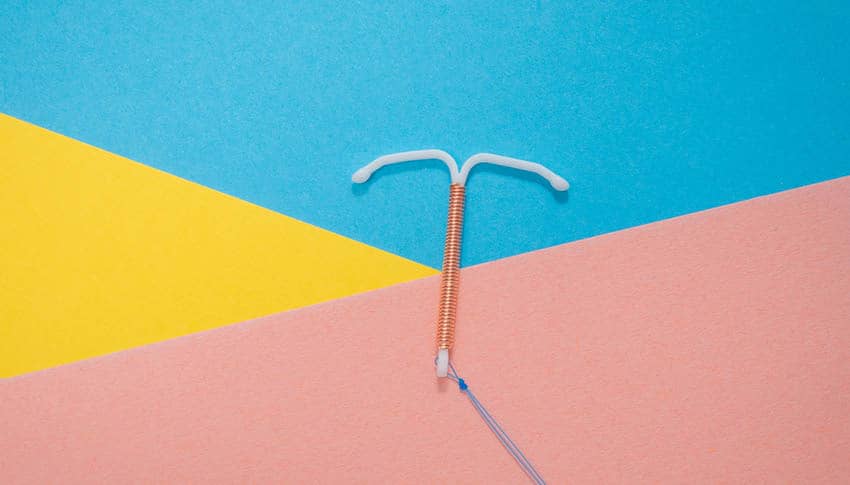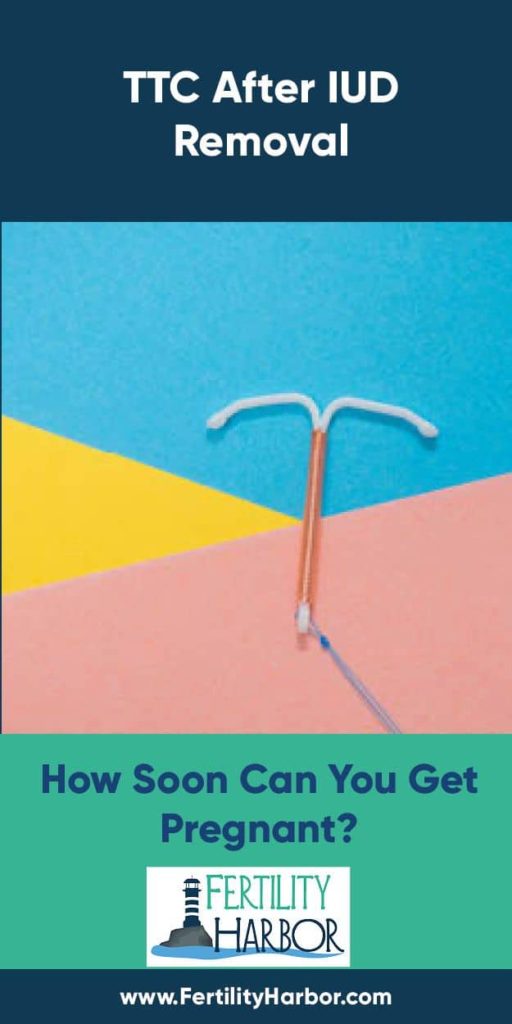This post was reviewed for medical accuracy by Rosalie Gunson, a Certified Registered Nurse Practitioner specializing in fertility care.
For lots of women, the first step in the TTC journey is stopping whatever birth control method they had been using — no more pills, condoms, or shots. But what if you were using an IUD?
Women can safely get pregnant soon after their hormonal or copper IUD is removed. Having had an IUD should have no impact on fertility — even if it’s been in for many years.
I figured I’d start this post with some basic IUD info. If you already have an IUD and want to start TTC soon, feel free to skip down.
What Are Intrauterine Devices (IUDs)?
IUDs are flexible little T-shaped objects that are inserted into the uterus for birth control. (IUD stands for “intrauterine device.”) Mirena and Paragard are two popular brand names of IUDs available in the United States.
IUDs require a prescription, and a medical professional has to insert it for you. Women typically have their IUDs put in by their primary care doctor, their gynecologist, or a nurse at a family planning clinic. The actual insertion process is over in 5 minutes. You don’t have to wait until any particular time in your menstrual cycle to do it.
Once the IUD is in, it will work for a long time — up to 5 to 10 years, depending on the type. That makes IUDs a great birth control option for women who don’t want to take a pill every day, or who had negative reactions to the Pill in the past.
IUDs are incredibly effective at preventing pregnancy when they’re used correctly, and they’re pretty foolproof. Once the IUD is inserted, you’re all set — there’s nothing to mess up. The main way IUDs fail is by slipping out of place, but most IUDs stay put with no problem.
If necessary, a doctor can check the position of your IUD with an ultrasound. Never had an internal ultrasound before? Check out my post Do Transvaginal Ultrasounds Hurt? for more info.
How Do IUDs Work for Birth Control?
So how do these little things prevent pregnancy? The answer depends on the type of IUD you are using.
The Mirena IUD, which is made of plastic, releases a constant low level of a synthetic form of the hormone progesterone (progestin). Progestin prevents pregnancy by thickening cervical mucus and generally making the uterus unfriendly to sperm. These IUDs are considered effective for up to 5 years.
Because they tend to thin the uterine lining, progestin IUDs have also been approved to treat heavy periods as well. (I go into more detail about the importance of a good uterine lining in the post Can You Get Pregnant With a 5 mm Endometrial Lining?) For some women, the progestin prevents ovulation too. No ovulation = definitely no pregnancy!
The Paragard IUD is also made of plastic, but it’s wrapped in copper. This type of IUD releases no hormones at all. That makes the copper IUD ideal for breastfeeding women and others who want a long-term, carefree form of birth control but cannot take hormones for medical reasons. And it’s good for up to 10 years!
You may wonder how exactly a little piece of copper can keep you from getting pregnant. It turns out that copper ions are toxic to sperm — the copper basically acts as spermicide. I don’t know how they figured this out, but it’s pretty cool!
This kind of IUD does not offer the same benefits for women with painful menstrual cycles. In fact, some women with the copper IUD report cramps and heavy bleeding during their periods. These symptoms may improve over time.
The copper IUD has one more benefit: it can also be used as emergency contraception for women who did not have an IUD already inserted. It’s actually more effective than the morning-after pill.
But hey, this is a fertility blog, so let’s get back to the point: getting your IUD removed so you can have a baby!
Should You Remove Your Own IUD? (No!)
It’s awesome that IUDs can be effective for so long, but they can’t stay in there forever. Eventually they need to come out.
IUDs have thin strings for removal. They’re sort of like the strings on a tampon, but thinner. Many people have compared them to fishing line. You shouldn’t just yank on the strings when you’re ready to get pregnant, though — IUDs should always be taken out by a professional.
So if you’re getting ready to TTC and you have an IUD, definitely make an appointment with your doctor to discuss your plans. For more info to help you prepare, see the post TTC Right After Your Wedding.
The good news is that removing the IUD doesn’t take much time at all. While some women report pain when their IUD was put in, the removal should be fast and smooth. You might notice a little cramping or spotting, but that’s it.
How Soon Can You Get Pregnant After Your IUD is Removed?
After your IUD is out, you can get started TTC right away! There’s no lingering effect from the IUD, and your cycle should return to normal very quickly.
Hurray, right? But here comes the big caveat…
Since IUDs can work for many years, it may have been a very long time since you experienced a totally natural menstrual cycle. Lots of women don’t discover that they have a fertility issue until they come off long-term birth control (whether that’s pills, shots, implants, or IUDs).
So if you’re hoping to get pregnant soon after you get your IUD taken out, have a plan for tracking your cycles with an app or plain old paper. You don’t have to go crazy with it, but you’ll want to know how long your cycles are and whether you have any signs of ovulation.
With any luck, you have textbook-perfect menstrual cycles and you’ll get your BFP within the first few months of IUD removal. But in case you don’t, it’s good to keep notes.
That way, if you end up talking to your doctor about potential infertility, you’ll have some data to work with. See Can Your PCP Prescribe Clomid (and Other Fertility Meds)? for more info.
If you had your IUD taken out a while ago and you still haven’t gotten a period, you may need to ask your doctor about restarting your cycle with Provera. For more info on this medication, check out How to Take Provera When TTC.
My posts When Do You Ovulate if You Have 45-Day Cycles and Should Regular Menstrual Cycles Be Considered a Vital Sign? have some helpful info on tracking your cycles and the importance of regular ovulation.
Do IUDs Lead to Infertility?
So you can start TTC as soon as you get your IUD removed… but have you somehow hurt your chances of conceiving by getting the IUD in the first place?
The short answer is no. IUDs were once thought to cause higher rates of pelvic inflammatory disease (PID), which can lead to infertility if the inflammation blocks the fallopian tubes. But newer studies have shown that this is not the case. (If you get a fertility workup, your doctor will likely do an HSG to make sure the fallopian tubes are open. For more info on that test, see Does an HSG Hurt? What to Expect.)
The main cause of PID is actually sexually transmitted infections. If you have chlamydia and get an IUD, you might develop pelvic inflammatory disease — but it wouldn’t be the IUD’s fault. That is one reason doctors ask about any history of STIs before the IUD is placed.
What If You Get Pregnant BEFORE Your IUD is Taken Out?
Assuming your IUD is inserted correctly, you really shouldn’t get pregnant. These little devices work amazingly well. But if you do — and again, it’s very rare!– your doctor will probably recommend removing the IUD to lower the risk of complications.
Conclusion
Copper and hormonal IUDs have become a very popular, convenient, and effective form of long-term birth control. When you’re ready to become a mom — or try for another child — you should be able to start TTC soon after the IUD is removed.
 This post was last updated in May 2020.
This post was last updated in May 2020.



 I’m Jenn! Here I am with my beautiful twin boys. My pregnancy was possible thanks to fertility treatment for PCOS.
I’m Jenn! Here I am with my beautiful twin boys. My pregnancy was possible thanks to fertility treatment for PCOS.


